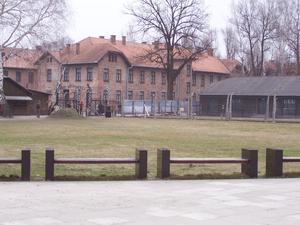Advertisement
Published: March 28th 2005

 Auschwitz
Auschwitz
Our first view of the infamous entrance to Auschwitz.Auschwtiz and Brikenau
How can I describe the indescribable? I do not believe I can, so I will not try. Rather I will write just a few words and then let the pictures I took speak.
I had forgotten that Auschwitz was an old Polish army base. Thus, all the buildings are brick. I thought the barracks were all of wood, but the wooden barracks were built at Brickenau. Brickenau, a much larger camp, was built when the Nazis decided that Auschwtiz was too small and too inefficient. Auschwitz had two small furnaces that could only cremate six bodies at one time. The Nazis would cram several hundred people into the “shower room,” kill them with poisonous gas and then it took three days to cremate all the bodies. Brickenau had four large furnaces that were much more efficient for their terrible purposes.
We visited Auschwtiz and Brikenau on Monday, the day after Easter. We had to be careful to stay with our group and not become separated as there were large numbers of groups visiting. As groups mingled and passed each other, it would have been very easy to have become lost in the crowd. I thought

 Auschwitz
Auschwitz
The sign over the entrance gate that says, "Work Makes You Free." Notice the B was welded upside down by a defiant prisoner.it very interesting to see several large groups of young people from Israel carrying large Israeli flags. They looked like teenagers from the States, some looked interested, some looked sad and others simply looked bored.
It seemed appropriate that on the day we visited it was quite chilly and the sky was overcast. Our discomfort of being a bit cold paled in comparison what so many Jews, gypsies, political prisoners and prisoners of war suffered here.
Advertisement
Tot: 0.079s; Tpl: 0.019s; cc: 11; qc: 26; dbt: 0.0373s; 1; m:domysql w:travelblog (10.17.0.13); sld: 1;
; mem: 1.1mb

 Auschwitz
Auschwitz
 Auschwitz
Auschwitz































Lesley Dickason
non-member comment
My friend and I went here in early December 2005. It had been snowing and was naturally cold. We had on tee-shirt and jumper, trousers, boots, socks, body warmers and a coat hat and gloves. We were chilly but the thought of all those people here with virtually no clothes on was unimaginable. The journey here was one of mixed feelings. My grandmother was born just outside Warsaw, came to England before Hitler ran riot, but in saying that most of her family were exterminated by this most sickest of men. I felt so sad on arrival at Birkenau. The thought of living (if that is what it can be called) I cannot imagine, and my thoughts and feelings are with those who died and of course, with those that managed to survive and their families.